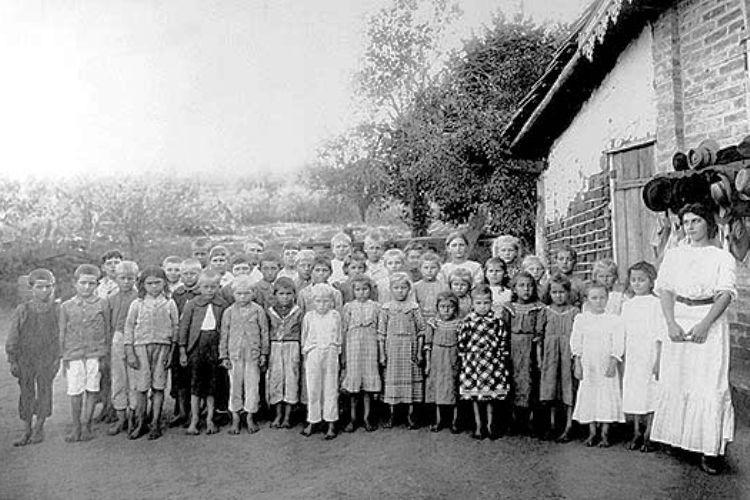
Italian Emigration: South American Countries

Figure 1.--Here we see a school attended by Italian children in Campinas (Sao Paulo State) about 1900. Immigration peaked in the late-19th century and until Brazil changed regulations on subsiudized immigration, Italins were the most important immigrant group during this period.
|
|
South America was another important destination for Italian immigrants. Italian emigration was especially important to Argentina, Brazil, and Uruguay. Italian emigrants were attracted to these Catholic countries, in part because of the cultural and linguistic affiities.
Emigration was at first to these coutries than to the United States. The Proestant culture and English language was at first seen as a seemingly insurmoutable or at least forboding barrier. It is unclear why emigration gradually shifted to the United states. The promotions by steamship companies and industrialists may have been a factor. We suspect that the greater relative success of immigrants in America spread word of mouth may have been the principal factor. A good example of an Italian-Brazilian family is the Quantri family which emigrated to Brazil.
Argentina
Italian immigration was especially important in the late-19th and early-20th centuries. Many Italians felt more comfortable emigrating to a Catholic country with a language similar to Italian. A reader writes, "I remember hearing people from Argentina and thinking their accent was different from most of South Americans. And about 2 years ago or so, a Chilean friend mentioned to me how Argentinians speak Spanish with an Italian accent due to the large presence of Italian immigrants." The most famous Italian-Argentine is Archbishop of Buenos Aires, Jorge Mario Bergoglio, who of course was elected Pope (2013). He was born and raised in Argentina with Italian origins. There are some 25 millionArgentines of Italian roots, that represents about 60 percent of the country entire population. They came Argenbtina and other South American countries (espevcially UruguayO in different generations. Most of them came during the great European immigration wave at the end of 19th century and the beginning of the 20th. This of course is the sane time tht Italians emigrated to the United states in large numbers. Italian immigration was a major part of the emigrant wave because Itzly was such a populsce country. And at the time Italy was facing major social and economic problems (1880-1920). Italians flocked to Argentina for the same reason that they camne to the United States--economic opportunity. And like the United States, Argentina had an open economic policy. In fact this was even codified in the Constitution because Argentine Governments wanted to expand the coyntry's population. Article 25 of the 1853 Constitution read, "The Federal Government shall encourage European immigration, and shall not restrict, limit, or obstruct, by taxation of any kind, the entrance into the Argentine territory of foreigners coming to it for the purpose of engaging in the cultivation of the soil, the improvement of industrial business, or the introduction and teaching of arts and sciences." And of course, Argentina was even more culyturally ttractive than nglish-spdaking, Proestant North America.
Many Europeans have emigrated to Brazil. Other than Poruguese, the largest European immigrant group in Brazil is Italian. A factor here is that Italy is one of the most populace European country, and the poorest of the major countries. Large numbers of Itlians emigrated to the United States, Argentina, and Brazil in the late-19th century and early 20th-century. Argentina and Brazil offfered cultural similarities (religion and language) that the United States did not offer. And in the 19th century it was not at all clear that America would emerge as such a succesful, rich country. In fact it look at the time that Argentina was going to become a very successful country. And there were high hopes for Brazil as well. As a result, many Italians opted for Argentina and Brazil rather than the United States. Italian emigration began shifting to the United States because of the greater economic opportunities there. Even larger numbers of Italuans eventually emigrated to the United States, despite the fact that America was a largely Protestant country. Economic opportunity was a major draw, but openess and toleration of cultural differences overcame the cultural similarities of Argentina and Brazil. More than a million Italians entered Brazil, far more than any other nationality (1884-1903). This was the peak period of immigration. The Prinetti Decree (1902) ended subsidised emigration to Brazil. This significantly reduced Italian immigration. After World War I the United States began restricting immigraion. This reduced the options for Italian and other European immigrants. Various sourcs estimate that Italians represent 10-15 percent of the population. This is based on cultural self identification. The relatively recent arrival of the Italians compared to the Portuguese meant that the Italian cultural footprint was much more pronounced. Actual etnicity may be somewhat less. Italians are especially imprtant in the São Paulo area. We note the Quadri family in 1927, an Italian immigrant family.
Uruguay
HBC

Navigate the Boys' Historical Clothing Italian pages:
[Return to the Main Itlalian emigration destination page]
[Return to the Main Itlalian immigration page]
[Return to the Main Itlalian page]
[Italian art]
[Italian catalogs]
[Italian choirs]
[Italian movies]
[Italian royalty]
[Italian school uniforms]
[Italian youth groups]
Navigate the Boys' Historical Clothing Web Site:
[About Us]
[Introduction]
[Activities]
[Biographies]
[Chronology]
[Clothing styles]
[Countries]
[Girls]
[Theatricals]
[Topics]
[Bibliographies]
[Contributions]
[FAQs]
[Glossaries]
[Images]
[Links]
[Registration]
[Tools]
[Boys' Clothing Home]
Created: 1:44 AM 6/30/2017
Last updated: 1:45 AM 6/30/2017



